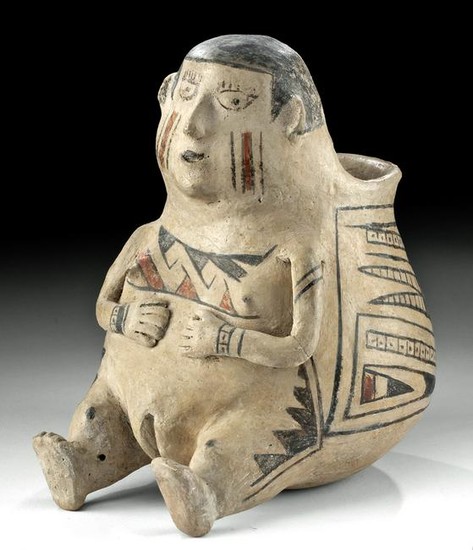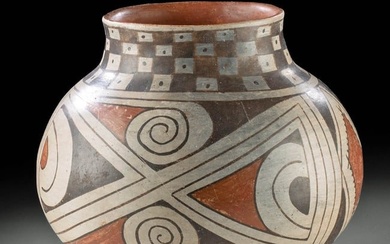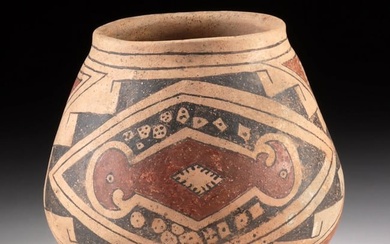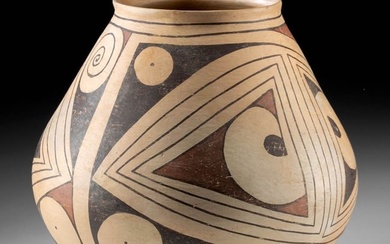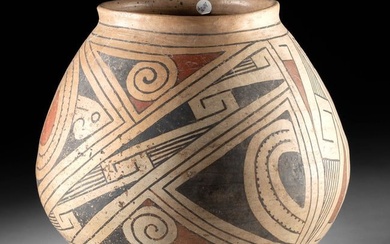Casas Grande Ramos Polychrome Female Effigy Vessel
Pre-Columbian, Mexico, Chihuahua, Casas Grandes (also known as Paquime), ca. 1280 to 1450 CE. A delightful, handbuilt and beautifully painted human effigy vessel depicting a nude seated female with features delineated in low to high relief, including breasts and genitalia, hands placed over the abdomen just beneath the breasts, and feet outstretched before her. Her head rises above the front rim of the vessel, with wonderful details delineated in relief and painted in red and black over the cream ground. These include wide open eyes with lashes, pursed lips, striated tattoo marks or face paint on her cheeks, a short coiffure, a band of nested zigzag motifs over her chest, 'beaded' bracelets, armlets on one arm, a single dot on each knee, and step motifs adorning her hips. On the opposite side of the vessel which perhaps doubles as her rounded back is a central serpent motif comprised of checkerboard and solid panels, an expressive visage with open eyes and a forked tongue emerging from a toothy mouth, as well as a forked tail. Size: 6.5" L x 5.25" W x 7.5" H (16.5 cm x 13.3 cm x 19 cm)
Casas Grandes (Spanish for Great Houses; also known as Paquime) is a prehistoric archaeological site in the northern Mexican state of Chihuahua. Casas Grandes is one of the largest and most complex Mogollon culture sites in the region. Settlement began after 1130 CE, and would see the larger buildings developed into multi-storied dwellings after 1350 CE. The community was abandoned approximately 1450 CE. Casas Grandes is regarded as one of the most significant Mogollon archaeological zones in the northwestern Mexico region, linking it to other sites in Arizona and New Mexico in the United States, and exhibiting the expanse of the Mogollon sphere of influence.
Provenance: ex-private collection of a physician, Florida, USA, acquired in 1980s
All items legal to buy/sell under U.S. Statute covering cultural patrimony Code 2600, CHAPTER 14, and are guaranteed to be as described or your money back.
A Certificate of Authenticity will accompany all winning bids.
We ship worldwide to most countries and handle all shipping in-house for your convenience.
#153068 Dimensions: Condition Report: Professionally repaired from multiple pieces with restoration over the break lines. Very well done. Minor surface wear, but painted imagery presents well. Old collection labels on underside. Small vent hole to inner leg.
View it on
Estimate
Time, Location
Auction House
Pre-Columbian, Mexico, Chihuahua, Casas Grandes (also known as Paquime), ca. 1280 to 1450 CE. A delightful, handbuilt and beautifully painted human effigy vessel depicting a nude seated female with features delineated in low to high relief, including breasts and genitalia, hands placed over the abdomen just beneath the breasts, and feet outstretched before her. Her head rises above the front rim of the vessel, with wonderful details delineated in relief and painted in red and black over the cream ground. These include wide open eyes with lashes, pursed lips, striated tattoo marks or face paint on her cheeks, a short coiffure, a band of nested zigzag motifs over her chest, 'beaded' bracelets, armlets on one arm, a single dot on each knee, and step motifs adorning her hips. On the opposite side of the vessel which perhaps doubles as her rounded back is a central serpent motif comprised of checkerboard and solid panels, an expressive visage with open eyes and a forked tongue emerging from a toothy mouth, as well as a forked tail. Size: 6.5" L x 5.25" W x 7.5" H (16.5 cm x 13.3 cm x 19 cm)
Casas Grandes (Spanish for Great Houses; also known as Paquime) is a prehistoric archaeological site in the northern Mexican state of Chihuahua. Casas Grandes is one of the largest and most complex Mogollon culture sites in the region. Settlement began after 1130 CE, and would see the larger buildings developed into multi-storied dwellings after 1350 CE. The community was abandoned approximately 1450 CE. Casas Grandes is regarded as one of the most significant Mogollon archaeological zones in the northwestern Mexico region, linking it to other sites in Arizona and New Mexico in the United States, and exhibiting the expanse of the Mogollon sphere of influence.
Provenance: ex-private collection of a physician, Florida, USA, acquired in 1980s
All items legal to buy/sell under U.S. Statute covering cultural patrimony Code 2600, CHAPTER 14, and are guaranteed to be as described or your money back.
A Certificate of Authenticity will accompany all winning bids.
We ship worldwide to most countries and handle all shipping in-house for your convenience.
#153068 Dimensions: Condition Report: Professionally repaired from multiple pieces with restoration over the break lines. Very well done. Minor surface wear, but painted imagery presents well. Old collection labels on underside. Small vent hole to inner leg.
